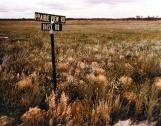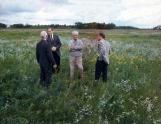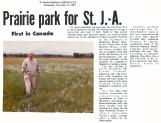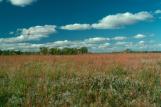1
Original tall grass prairies have probably been less studied over an extended period of time than any other natural area. By the late 1960's biologists viewed the need to preserve true tall grass prairie in Canada as a matter of some urgency.It was fortuitous that in the mid 60's International Biological Program (IBP) was set up. Growing out of scientists' concern for rapidly increasing population, food shortages and environmental degradation, the IBP was created to help provide a scientific basis for a comprehensive world program to preserve biologically important areas.
University of Manitoba botanist, Dr. Jennifer Walker, urged the IBP to recognize Canadian tall grass prairie as biologically important and to identify a representative tract. To this end, she organized a team of botanists, who covered more than 8,000 kilometers in 1968 to evaluate about 60 proposed areas.
3
The IBP found the 150 acres in what was then the city of St. James, to be "by far the largest remaining natural prairie." The St. James Parks Board believed the old "McDermott" site which represented prairie ecology, geology and topography could serve well for both research and education purposes. But it remained up to the St. James-Assiniboia City Council to create the preserve on the property which was in the heart of a proposed housing development. Although the land was zoned for general agriculture, the value of the land was estimated at $750,000 for purchase by a developer-too much for at least one alderman for growing so-called "weeds".The chairman of the Parks Board, Mike Gwiazda, however, maintained that the prairie plot could become a wildflower park of great significance. Karen Johnson, a regional coordinator of the IBP, also urged the city to keep the property as one plot rather than let it be divided. Such experts as Dr. Robert Nero of the Manitoba Museum, and Dr. Jennifer Walker, urged the Parks Board:
"not to make the mistake…of allowing unique and irreplaceable areas to be destroyed for short-term gain, while ignoring the ….needs of their citizens…It will be to neither St. James-Assiniboia's or Manitoba's credit if, in the Centennial year celebrating the homesteading of this Province, the last remnant of true prairie within its borders is destroyed."
In April 1970, with the active support of the local community, the city council agreed to set aside 25.6 acres for the park, with 1.5 acres for an interpretive center and parking lot. The remaining available land—about 28 acres—was committed to "practical purposes" (eventually a school, parking area, and apartment building).
4
Now the Prairie View Road Intersection, looking out at current day tall grass prairie preserve.1970
Living Prairie Museum, St. James, Winnipeg, Manitoba, Canada

5
Doug Ross and Ed Russenholt at the opening of the Living Prairie Museum opening1974
Living Prairie Museum, St. James, Winnipeg, Manitoba, Canada

6
Announcement of the prairie preserve in St. James Assiniboia.19 November 1969
Living Prairie Museum, St. James, Winnipeg, Manitoba, Canada

7
The park was officially opened in April 1974, the interpretive centre in 1976. Presently the museum is under the jurisdiction of the City of Winnipeg, Parks and Open Spaces Division.8
Jules Leger, Governor General, at the Living Prairie Museum's Official Dedication Ceremony.26 May 1974
2795 Ness Ave, Living Prairie Museum, St. James, Winnipeg, Manitoba, Canada

9
The monument commemorating Living Prairie Museum26 April 1974
Living Prairie Museum, St. James, Winnipeg, Manitoba, Canada

10
Dedication Ceremony official accepting crocus gift26 April 1974
Living Prairie Museum, St. James, Winnipeg, Manitoba, Canada

11
Peter De Wet speaking at the Official Opening of the Living Prairie Museum Interpretive Centre23 June 1976
2795 Ness Ave, Living Prairie Museum, St. James, Winnipeg, Manitoba, Canada

12
Mayor Stephen Juba cutting the ribbon with scythe23 June 1976
Living Prairie Museum, St. James, Winnipeg, Manitoba, Canada
 Credits:
Credits:Image from: Winnipeg Free Press, June 24, 1976
13
Living Prairie Museum, Interpretive Centre1980
2795 Ness Ave, Living Prairie Museum, St. James, Winnipeg, Manitoba, Canada

